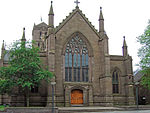Dundee railway station
Former North British Railway stationsPages with no open date in Infobox stationRailway stations in DundeeRailway stations in Great Britain opened in 1878Railway stations served by Caledonian Sleeper ... and 4 more
Railway stations served by CrossCountryRailway stations served by London North Eastern RailwayRailway stations served by ScotRailUse British English from December 2017

Dundee railway station serves the city of Dundee on the east coast of Scotland. It is situated on the northern, non-electrified section of the East Coast Main Line, 59+1⁄4 miles (95.4 km) northeast of Edinburgh. Dundee is the tenth busiest station in Scotland. In January 2014, the former main station building was demolished to make way for a new building as part of the Dundee Waterfront Project which opened on 9 July 2018. Dundee railway station is where the Edinburgh–Dundee line meets the Glasgow–Dundee line, via Perth. It is also the start of the Dundee to Aberdeen line.
Excerpt from the Wikipedia article Dundee railway station (License: CC BY-SA 3.0, Authors, Images).Dundee railway station
Riverside Drive, Dundee Waterfront
Geographical coordinates (GPS) Address Nearby Places Show on map
Geographical coordinates (GPS)
| Latitude | Longitude |
|---|---|
| N 56.4566 ° | E -2.971 ° |
Address
Riverside Drive
DD1 4BF Dundee, Waterfront
Scotland, United Kingdom
Open on Google Maps








